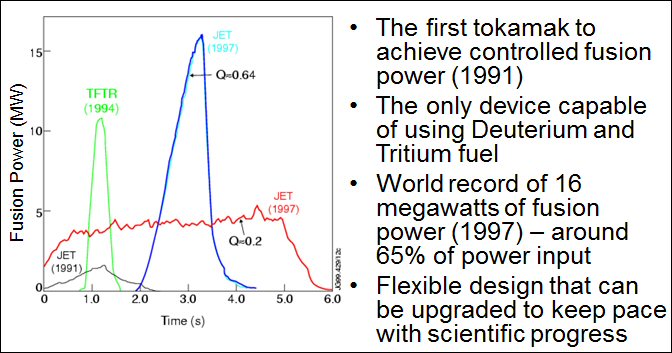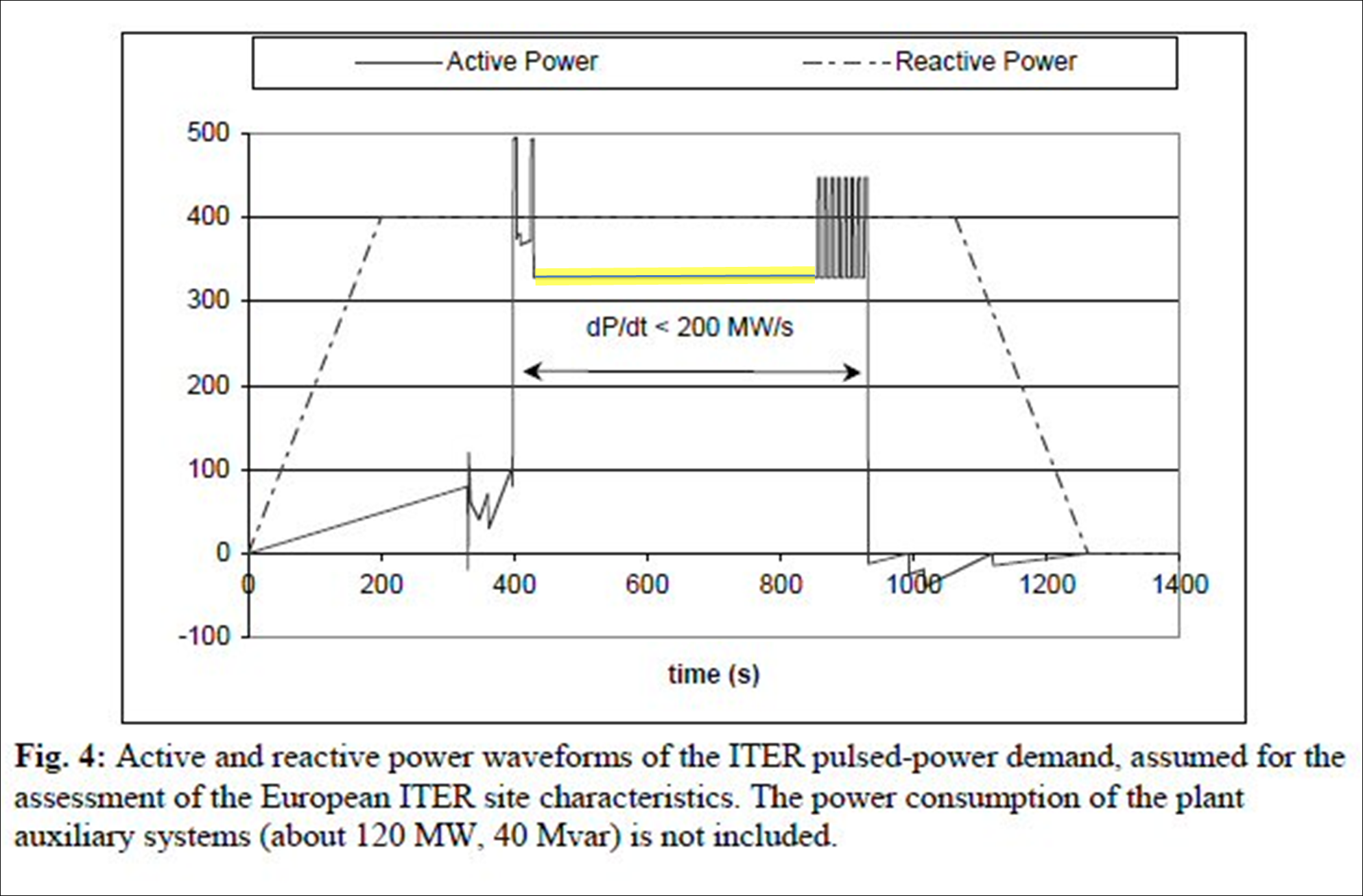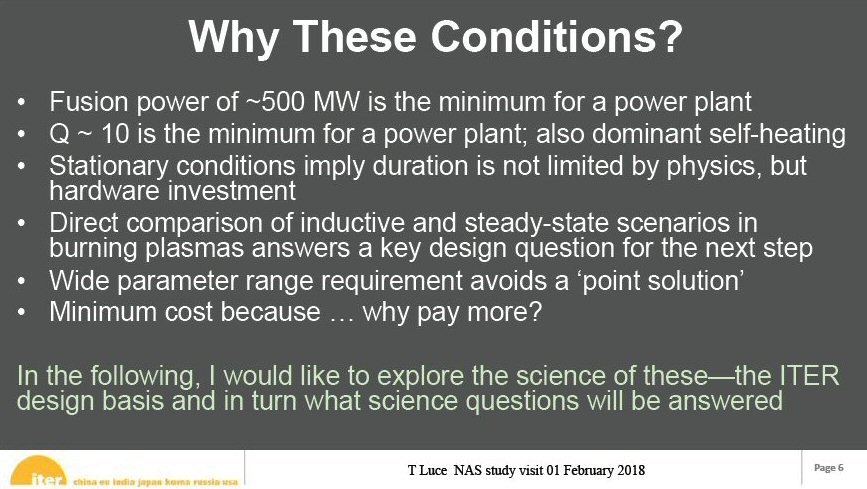#61. My Conversation With the Chief Scientist of the ITER Organization
Cliquez ici pour la Version Française
Return to ITER Power Facts Main Page
By Steven B. Krivit
Nov. 21, 2020
This article describes a fascinating correspondence I had over the course of three days in October 2020 with Dr. Tim Luce, the chief scientist of the ITER organization. I initiated the conversation in response to a statement he made about the rate of thermal power output the ITER reactor is designed to produce.
A little background information will help newcomers to my ITER investigation, but if you’re already familiar with it, you may want to drop down to the subheading THE MONEY.
JET
On October 31, 1997, the Joint European Torus (JET) reactor in Culham, U.K., had produced fusion particles with a record-setting level of thermal power for two seconds. At its peak, the fusion reactions produced thermal power at a rate of 16 million Watts. That’s the blue line in the graph below. The graph and the text are from a slide presentation by Nick Holloway, the spokesman for the United Kingdom Atomic Energy Authority.

JET’s record-setting 1997 fusion result, shown in Nick Holloway’s slide presentation.
In 2014, I had figured out that many fusion scientists and their promoters had been making false claims about the results of this experiment. They had done so since at least 1974. It had become commonplace to say that JET had produced thermal power from fusion at a rate of 16 MW from a total input rate of only 24 MW. Here’s an example from the ITER organization’s Web site before I advised them to correct it. Here’s an example from a European Parliament publication before I told them fusion experts had misled them.
I and, it seemed, everybody else who was not a fusion scientist, including Holloway, thought that JET had produced its 16 MW world’s record from a total reactor input power rate of only 24 megawatts of electricity, thus producing 65 percent of the power rate consumed by the entire reactor.
When I realized in 2014 that the 24 MW input value was not the correct value for the reactor input, I searched the Internet for the real value. As far as I could tell, it did not exist on any public Web page. So I sent Holloway an e-mail and asked him for the information. He didn’t know, either, but he asked his colleague Chris Warrick. Two days later, Holloway got back to me. They said that JET needed an input electrical power rate of 700 MW, not 24 MW. That meant that JET’s world-record of 16 MW of power was not 65 percent of the power input rate, but only 1 percent.
ITER
Soon after I received this revelatory information, I began looking at the public claims that fusion scientists and their promoters were making about the newer and larger ITER reactor. I could see that they were using the same ambiguous language they had used with JET for years. I knew that the expected thermal power output rate of 500 MW was accurate. I knew that the claimed input power rate of only 50 MW — for the overall reactor — was false. But the ITER organization did not clearly publish the correct input value on its web site. I didn’t have time to hunt down the correct input power rate until the end of 2016.
In December 2016, I sent an e-mail to Bernard Bigot, the director-general of the ITER organization, and asked him for the correct input power rate for the overall reactor. He didn’t respond. I began an e-mail conversation with Laban Coblentz, the spokesman for the organization. Coblentz told me it would be too difficult to figure out a simple, single value for the required input power for the reactor.

Laban Coblentz, ITER Organization Spokesman
Only recently, in hindsight, I realized that, buried deep in his e-mails, the information was there. But it was for me, at the time, technical mumbo-jumbo. I would have had to synthesize the input power value from two primary sets of power drains Coblentz had given me for the reactor. The first power drain will consume electrical power at a rate of 150 MW, and the other will be 120 MW. So Coblentz knew that the required input power rate for ITER — to produce its 500 MW thermal output rate — was 270 MW of electricity.
If we assume that Coblentz knew the well-known loss associated with converting thermal power to electrical power, then he knew that the projected net ITER reactor output was equivalent to zero Watts. Nevertheless, since January 2017, Coblentz has continued to publish press releases and Web pages on the organization’s Web site that falsely state or create the false impression that the overall ITER reactor output should be ten times the overall reactor input and that the ITER reactor design is equivalent to that of a small, commercial electric power plant.
300 MW
The first person to give me a clear, concise input power rate value for the ITER reactor design — 300 MW — was Daniel Jassby, a retired plasma physicist from the Princeton Plasma Physics Laboratory. This was in the summer of 2017. He was also the first person to clearly explain to me how the ITER reactor is designed to consume the various types of electrical power feeds. Soon after, I located two other sources who independently gave me numbers in the same ballpark. (All of my sources are listed here.)
440 MW
But if there’s one person in the ITER organization who knows the rate of input electrical power that the overall reactor is designed to consume, it’s Ivone Benfatto. He’s the head of the Electrical Engineering Division for the ITER organization.

Ivone Benfatto
I’ve had a copy of his scientific article “Power Converters for ITER” for many years, but I didn’t understand it well until recently. One of the tricky things to understand is that, although the reactor needs three categories of input power, only two of them are consumed. In the graph and caption below, Benfatto calls one of them “active power” and the other “plant auxiliary systems.” The third category is called “reactive power.” That power is stored, returned, and not consumed. It’s primarily used by the superconducting magnet system.
I knew early on from my conversations with Coblentz and Jassby that, when the ITER reactor begins its 500-second experiment, a brief spike is expected for about 20 seconds. When it shuts down, a short period of power oscillation is also expected. Coblentz called these “end-effects.”
Benfatto ran a computer simulation of the power loads expected during the experiment. For most of the 500-second experiment, the active power demand is expected to plateau at a rate of about 320 MW. I’ve highlighted that part of the power waveform. The plant auxiliary systems will use another 120 MW, bringing the total input electrical rate to 440 MW. I don’t know why Benfatto’s overall input power value is higher than the 300 MW value that other sources provided to me, but I have used the 300 MW number in my reports to be conservative. I’ve sent Benfatto several e-mails, but he’s never replied.

Benfatto computer simulation of ITER reactor active and reactive power drains
ZERO NET POWER
I’ve spent a lot of time talking with fusion experts about the thermal power that could be recovered from a reactor design like ITER. The consensus, assuming an input power load of only 300 MW (rather than 440 MW) and relatively optimistic gains and losses, is that the ITER design, if its thermal output was converted to electricity, would produce about zero Watts. (Click here for a full breakdown of the power balance.)
THE MONEY
Here’s the next piece of background information on the Tim Luce story: In 2013, the U.S. Congress, after seeing delays in the ITER construction schedule, began questioning whether it should continue spending the public’s money on ITER. Congress directed Ernest Moniz, the Secretary of Energy to look into it. Three years later, in 2016, Moniz recommended that the U.S. continue to be a partner for another two years, through fiscal year 2018. But Moniz advised that the U.S. participation should be reevaluated at that time. The secretary’s office asked the National Academies of Sciences to help. In turn, the academy formed a blue-ribbon committee of fusion authorities to ponder the matter. The committee recommended continued U.S. participation in the international project.
LUCE
Before the National Academies of Sciences committee review concluded, it held several meetings to talk about ITER. On February 1, 2018, it held its fourth meeting. It took place at ITER headquarters in France. The meeting began with a welcome address from Bigot. After that, senior members of the European fusion community gave presentations. In the afternoon, Luce gave his presentation.
Luce said that the ITER reactor design represents the minimum power production needed for a commercial fusion power plant.

The only way that the ITER reactor, designed for a gross thermal output of 500 MW, could be the “minimum for a power plant” is if it didn’t require the majority of the 300 MW of power it would need to operate. I emailed Luce and told him that a commercial fusion reactor designed with the parameters of ITER wouldn’t be able to produce one Watt of electricity.
Luce disagreed, and wrote back that ITER’s output, if converted to electricity, would be 100 MW, enough for a small fusion power plant:
My assumption is that “power plant scale” is >100 MW of electricity generation. 500 MW fusion power with a balance-of-plant efficiency of 0.2 (not economically viable, but the minimum) would be at 100 MW electric.
I showed him my analysis of the ITER reactor design power balance. Luce argued that the power values in my analysis included something called recirculating power. I told him that my values did not include recirculating power. Then he argued that my values included the temporary (reactive) power drain for the magnet system. I told him that they didn’t. Finally, in e-mail No. 17, Luce told me that the electrical power rate needed to operate ITER wasn’t 300 but somewhere between 100 and 150 megawatts and, therefore, the reactor would produce net output power equivalent to a rate of 100 MW of electricity.
I realized then that Luce had no idea about the rate of electrical power ITER would need to operate. I sent him my sources. A day later, after seeing my sources, Luce wrote back to me and said that his original calculation was an “off-the-cuff estimate.” He backtracked further and emphasized that the ITER project was not designed for net electricity.
I wrote back to him and told him that everybody knows that ITER is not designed for net electricity. The problem, I said, was that he told everybody at the National Academies’ meeting and he told our government that the ITER design would demonstrate the minimum performance needed for a working power plant. The only way this could be true was if Luce was underreporting the required input power. I asked Luce whether he disputed the 300 MW reactor input value and, if not, whether he would withdraw his statement that, in the ITER design, “fusion power of ~500 MW is the minimum for a power plant.”
Three weeks later, Luce wrote back. He continued to defend his claim.
“To a scientific audience,” Luce wrote, “I argued that this was the minimum size to be credible as saying the demonstration was from a plasma at the power plant scale.”
Yes, certainly, a 500-megawatt plasma itself is at “power-plant scale.” But if the input power required to create that plasma is subtracted, you get a net output rate of zero Watts — not quite “the minimum for a power plant.”
He argued that I didn’t understand the subject because I had used some terms incorrectly. Next, he wrote a long paragraph saying that the sources I had quoted for the 300 MW number — including Laban Coblentz, the ITER organization spokesman; Steve Cowley, the director of the Princeton Plasma Physics Laboratory and the former director of the United Kingdom Atomic Energy Authority; and Hartmut Zohm, the head of the Tokamak Scenario Development Division at the Max-Planck-Institute of Plasma Physics — were not credible.
The only thing Luce did not factually dispute was the 300 MW number I had been given by these independent sources. Luce ended his e-mail with a demand that I not publish any parts of our conversation.
See No Evil, Hear No Evil
The fact that the chief scientist of the largest and most expensive science project on Earth seemed unfamiliar with such a crucial fact is the first part of this story. The second part is that every fusion scientist who was in the room either went along with Luce’s false and exaggerated claim or didn’t realize it was false.
Consistent Trend
Here’s part three of the story. I was curious about other public power claims Luce might have made. Claiming a falsely lower input power rate is effectively the same as claiming a falsely higher output power rate. Either falsehood results in an exaggeration of the net output.
I learned that, when Luce spoke with other journalists, he didn’t just tell them, as he told me, that ITER’s required input power rate was between 100 MW and 150 MW. He told them ITER would need a rate of only 50 MW to operate.
In a 2018 article in La Repubblica, Luce told the journalist, “We plan to produce 500 megawatts with 50 megawatts of consumption.”
He was playing the same trick as everyone else who had been making false claims about ITER. He gave the journalist the 50 MW value, which is only the value of the heating power rate that is injected into the fuel. Luce implied that this 50-megawatt value was the rate of power that the entire reactor would need to operate. But the 50-megawatt value represents, at most, only 16 percent of the power that the entire reactor would need continuously to operate.
I was puzzled. Why would a scientist in such a prominent position, representing the most expensive science project on Earth, tell a journalist that ITER would consume only 50 megawatts rather than 300 megawatts? Even if Luce mistakenly believed that ITER would need an input rate of only 100 megawatts to operate, why did he tell the journalist it would need only 50 MW? I looked to see whether these statements were exceptional or the norm for Luce.
I found an article in the Guardian from 2019. After speaking with Luce, the journalist conveyed to the Guardian readers the same falsehood, that ITER is designed to produce 10 times as much power as it needs to operate.
I found an article in Le Parisien in which Luce told journalists that the objective of the reactor was to produce 10 times more energy than it consumes, a 500 megawatt output for a 50 megawatt input.
Luce was interviewed in August this year by Intellect Interviews. He said the same thing, “We’re getting 10 times the energy out than we’re putting in.” Here’s the key point in all of his public communications: Luce made no effort to identify his 50 MW value as the rate of thermal power injected to heat the plasma. Instead, he clearly and consistently implied that the overall reactor would need a rate of only 50 MW to operate.

Tim Luce, ITER Organization Chief Scientist
I also found an article from September 2020 in which Luce and Bigot were interviewed by Nature magazine and Luce said that ITER, without limiting the values to the plasma thermal input and output, was designed to produce 500 megawatts of power, ten times the input.
Why would a smart and knowledgeable scientist keep telling journalists and the public, and maybe government officials, that ITER is designed to produce 500 megawatts of power from only 50 megawatts of input power without making any effort to inform people what those numbers really meant? I considered writing another e-mail and asking him.
But I realized why he had given misleading information to the news media, the public, and the government about what ITER is designed to do. That’s what Bigot paid him to do.

